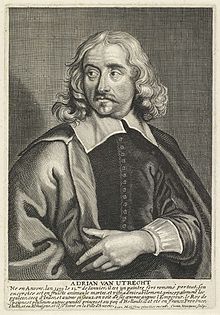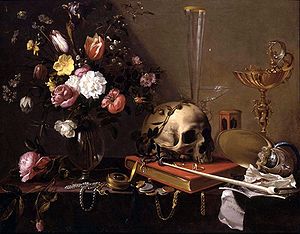Adriaen van Utrecht
The two artists are considered the main inventors of the genre of the pronkstillevens, i.e. still lifes that emphasized abundance by depicting a diversity of objects, fruits, flowers and dead game, often together with living people and animals.
He was a regular collaborator with leading Antwerp painters who had been pupils or assistants of Peter Paul Rubens, such as Jacob Jordaens, David Teniers the Younger, Erasmus Quellinus II, Gerard Seghers, Theodoor Rombouts, Abraham van Diepenbeeck and Thomas Willeboirts Bosschaert.
[6] Van Utrecht became a successful artist who received international commissions from the Emperor of Germany, king Philip IV of Spain and the Prince of Orange.
Van Utrecht also painted barnyard scenes with living animals, typically including poultry such as chickens, turkeys, ducks and peacocks.
Van Utrecht did not favor bright colours the way Snyders did but rather preferred warm earthen tones, especially grey-green, and strong chiaroscuro effects.
[8] Adriaen van Utrecht created market and kitchen scenes which incorporated large still lifes of game, fish, vegetables and fruit.
As in Snyders' composition, van Utrecht's Fishmonger Stall relies on the human figures and hanging fish to create the vertical component in contrast to the horizontal element of the table.
While the woman is negotiating with the fishmonger she is the victim of a robbery by a young boy who is cutting her purse while staring directly out of the picture towards the viewer.
[10] The elaborate still lifes produced by Frans Snyders and Adriaen van Utrecht in the 1640s accentuated overwhelming abundance by depicting a diversity of objects, fruits, flowers, and dead game, often in combination with human and animal figures.
It is clear that van Utrecht intended the composition to be a eulogy of the creative force of fire, which was involved in the production of many of the items depicted in the still life.
The subject of vanitas as depicted here was unusual for van Utrecht and shows that his role in the development of new types of still life has not been sufficiently recognized in art-historical literature.
He is known to have provided the still life elements in paintings by Jacob Jordaens, Erasmus Quellinus II, Jan Cossiers, Thomas Willeboirts Bosschaert.
[9][14] The collaborative work with Jan Cossiers (dated 1639, private collection) depicts van Utrecht with his wife Constancia in a kitchen amidst an extensive still life with game, lobster, fish and vegetables.
In particular, it is known that he was asked by court painter and designer Jan van den Hoecke to assist with a series of tapestries under the title 'Allegory of Time' (c. 1650) made for Archduke Leopold Wilhelm of Austria.
Ten preparatory oil sketches that van den Hoecke made for the series have survived (four in the Kunsthistorisches Museum, Vienna), as have eight tapestries based on the designs for Day and Night and The Months.








